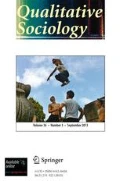Summary
When doing quantitative studies, we usually need a statistically representative sample. The same is often not the case with qualitative studies where we need a sample with variations along the independent variables. The technique described here is simple to use and guarantees variations. A statistically representative sample, on the other hand, if small, often gives few variations. Thus, one could say that the technique presented is a kind of statistically nonrepresentative stratified sampling useful in qualitative studies.
Similar content being viewed by others
References
Bott, Elisabeth 1957 Family and Social Network. London: Tavistock.
Glaser, Barney G. and Anselm L. Strauss 1967 The Discovery of Grounded Theory. Chicago: Aldine.
Komarowsky, Mirra 1967 Blue Collar Marriage. New York: Vintage.
Rubin, Lillian Breslow 1976 Worlds of Pain. New York: Basic Books.
Author information
Authors and Affiliations
Additional information
The author wishes to thank the editors ofQualitiative Sociology for valuable comments and suggestions made on an earlier version of this note.
Rights and permissions
About this article
Cite this article
Trost, J.E. Statistically nonrepresentative stratified sampling: A sampling technique for qualitative studies. Qual Sociol 9, 54–57 (1986). https://doi.org/10.1007/BF00988249
Issue Date:
DOI: https://doi.org/10.1007/BF00988249



